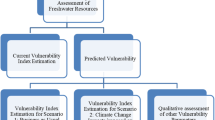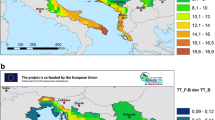Abstract
In the Aegean Islands, the continued availability of freshwater resources is of fundamental concern. This study analyzes the freshwater system for the Island of Lesvos by simultaneously conceptualizing various issues surrounding it using vulnerability assessment as a quantitative tool. The endpoint approach to vulnerability assessment was applied by developing a numerical expression based on a set of 25 quantitative and qualitative indicators; the indicators were identified as proxies to reflect the various conspicuous and inconspicuous issues surrounding water resources of the Island. In addition, concurrent visualization of the indicators was carried out by plotting radar charts. The assessment indicated that the Lesvian hydrogeological system has significant vulnerabilities emanating from both natural and anthropogenic pressures in addition to a poor adaptive capacity to counter perturbations; this was corroborated by the composite water vulnerability index which was calculated to be 0.69. Based on the analysis of the assessment results, the priority management targets and existing management optimization tools, the authors propose a quantitative framework that could aid the development of an effective methodology for addressing problems in water resource management; this approach couples adaptive water management with vulnerability assessment. The proposed methodology may represent a tool for identification of better solutions to water management–decision problems and/or provide important insights during decision making in similar environments.







Similar content being viewed by others
References
Adger WN (2006) Vulnerability. Global Environ Change 16(3):268–281. doi:10.1016/j.gloenvcha.2006.02.006
Adger WN, Vincent K (2005) Uncertainty in adaptive capacity. CR Geosci 337(4):399–410. doi:10.1016/j.crte.2004.11.004
Allen CR, Fontaine JJ, Pope KL, Garmestani AS (2011) Adaptive management for a turbulent future. J Environ Manage 92(5):1339–1345. doi:10.1016/j.jenvman.2010.11.019
Barnett J (2001) Adapting to climate change in Pacific Island countries: the problem of uncertainty. World Devel 29(6):977–993. doi:10.1016/S0305-750X(01)00022-5
Bates B, Kundzewicz ZW, Wu S, Palutikof J (2008) Climate Change and Water: Technical Paper VI. Intergovernmental Panel on Climate Change (IPCC), Geneva
Belegri-Roboli A, Michaelides PG (2006) Measuring technological change in Greece. J Technol Transf 31(6):663–671. doi:10.1007/s10961-006-0021-9
Berrang-Ford L, Ford JD, Paterson J (2011) Are we adapting to climate change? Global Environ Change 21(1):25–33. doi:10.1016/j.gloenvcha.2010.09.012
Brown A and Matlock MA (2011) A review of water scarcity indices and methodologies. White paper 106. The Sustainability Consortium, University of Arkansas, United States. Available at: https://www.sustainabilityconsortium.org/wp-content/themes/sustainability/assets/pdf/whitepapers/2011_Brown_Matlock_Water-Availability-Assessment-Indices-and-Methodologies-Lit-Review.pdf
Budsaba K, Smith CE, Riviere JE (2000) Compass plots: a combination of star plot and analysis of means to visualize significant interactions in complex toxicology studies. Toxicol Mech Methods 10(4):313–332. doi:10.1080/105172300750048764
Carter J, Howe J (2006) Stakeholder participation and the water framework directive: the case of the Ribble Pilot. Local environment 11(02):217–231. doi:10.1080/13549830600558564
Copestake J, Williams R (2013) Improving the value of development consultants as policy advisors: a four-stage model for more effective bespoke solutions. Oxford Policy Management, United Kingdom
Demetropoulou L, Nikolaidis N, Papadoulakis V, Tsakiris K, Koussouris T, Kalogerakis N, Koukaras K, Chatzinikolaou A, Theodoropoulos K (2010) Water framework directive implementation in Greece: introducing participation in water governance—the case of the Evrotas River Basin management plan. Environ Policy Gov 20(5):336–349. doi:10.1002/eet.553
Döll P (2009) Vulnerability to the impact of climate change on renewable groundwater resources: a global-scale assessment. Environ Res Lett 4(3):035006. doi:10.1088/1748-9326/4/3/035006
Dutra LX, Thébaud O, Boschetti F, Smith AD, Dichmont CM (2015) Key issues and drivers affecting coastal and marine resource decisions: participatory management strategy evaluation to support adaptive management. Ocean Coast Manag 116:382–395. doi:10.1016/j.ocecoaman.2015.08.011
European Commission (EC) (2015) Report on the progress in implementation of the Water Framework Directive Programmes of Measures. EC, Brussels. Availabe at: http://ec.europa.eu/environment/water/participation/map_mc/countries/greece_en.htm
Field CB (2012) Managing the risks of extreme events and disasters to advance climate change adaptation: special report of the intergovernmental panel on climate change. Cambridge University Press, New York
Food and Agriculture Organization (FAO) (2015) AQUASTAT online database. Website accessed on 10 June, 2015
Gatsis I, Koukoulas S, Vafeidis A, Lagoudakis E, Gkoltsiou K (2006) Monitoring and mapping of land cover/use changes in an agricultural and natural environment, using multitemporal satellite data and gis (lesvos island, greece). In Proceedings of RSPSoc Annual Meeting, University of Cambridge, United Kingdom
Gikas P, Angelakis AN (2009) Water resources management in Crete and in the Aegean Islands, with emphasis on the utilization of non-conventional water sources. Desalination 248(1):1049–1064. doi:10.1016/j.desal.2008.10.021
Gikas P, Tchobanoglous G (2009) Sustainable use of water in the Aegean Islands. J Environ Manage 90(8):2601–2611. doi:10.1016/j.jenvman.2009.01.020
Hahn T, Olsson P, Folke C, Johansson K (2006) Trust–building, knowledge generation and organizational innovations: the role of a bridging organization for adaptive co–management of a wetland landscape around Kristianstad, Sweden. Human ecology 34(4):573–592. doi:10.1007/s10745-006-9035-z
Halvadakis K (2000) Study for the development of an integrated management plan for OMW for the Island of Lesvos. Final Report. Aegean University, Lesvos, Greece (in Greek)
Hamouda MA, El–Din MMN, Moursy FI (2009) Vulnerability assessment of water resources systems in the Eastern Nile Basin. Water Resour Manage 23(13):2697–2725. doi:10.1007/s11269-009-9404-7
Hellenic Statistical Authority (2010) Concise Statistical Yearbook. URL: http://dlib.statistics.gr/Book/GRESYE_01_0003_00040.pdf
Hill M (2013) Adaptive capacity of water governance: cases from the Alps and the Andes. Mountain Research Development 33(3):248–259. doi:10.1659/MRD-JOURNAL-D-12-00106.1
Iglesias A, Garrote L, Flores F, Moneo M (2007) Challenges to manage the risk of water scarcity and climate change in the Mediterranean. Water Resour Manage 21(5):775–788. doi:10.1007/s11269-006-9111-6
Jiménez BE, Oki T, Arnell NW, Benito G, Cogley JG, Döll P, Jiang T, Mwakalila SS (2014) Freshwater resources. In Climate Change 2014: Impacts, Adaptation, and Vulnerability. Part A: Global and Sectoral Aspects. Contribution of Working Group II to the Fifth Assessment Report of the Intergovernmental Panel on Climate Change [Field, C.B., V.R. Barros, D.J. Dokken, K.J. Mach, M.D. Mastrandrea, T.E. Bilir, M. Chatterjee, K.L. Ebi, Y.O. Estrada, R.C. Genova, B. Girma, E.S. Kissel, A.N. Levy, S. MacCracken, P.R. Mastrandrea, and L.L. White (eds.)]. Cambridge University Press, New York
Jones RN (2000) Managing uncertainty in climate change projections–issues for impact assessment. Clim Change 45(3–4):403–419. doi:10.1023/A:1005551626280
Kaldellis JK, Kondili EM (2007) The water shortage problem in the Aegean archipelago islands: cost–effective desalination prospects. Desalination 216(1):123–138. doi:10.1016/j.desal.2007.01.004
Kanakoudis V, Tsitsifli S (2010) On-going evaluation of the WFD 2000/60/EC implementation process in the European Union, seven years after its launch: are we behind schedule? Water Policy 12(1):70–91. doi:10.2166/wp.2009.092
Kanellopoulos C, Argyraki A (2013) Soil baseline geochemistry and plant response in areas of complex geology. Application to NW Euboea, Greece. Chemie der Erde-Geochem 73(4):519–532.
Kanellopoulos C, Argyraki A, Mitropoulos P (2015) Geochemistry of serpentine agricultural soil and associated groundwater chemistry and vegetation in the area of Atalanti, Greece. J Geochem Explor 158:22–33
Kapellakis IE, Tsagarakis KP, Crowther JC (2008) Olive oil history, production and by–product management. Rev Environ Sci Bio Technol 7(1):1–26. doi:10.1007/s11157-007-9120-9
Karagiannis IC, Soldatos PG (2007) Current status of water desalination in the Aegean Islands. Desalination 203(1):56–61. doi:10.1016/j.desal.2006.04.006
Karavitis CA, Kerkides P (2002) Estimation of the water resources potential in the island system of the Aegean Archipelago, Greece. Water Int 27(2):243–254. doi:10.1080/02508060208686998
Kizos T, Plieninger T, Schaich H (2013) “Instead of 40 Sheep there are 400”: traditional Grazing Practices and Landscape Change in Western Lesvos, Greece. Landscape Research 38(4):476–498. doi:10.1080/01426397.2013.783905
Komnenic V, Ahlers R and Van Der Zaag P (2009) Assessing the usefulness of the water poverty index by applying it to a special case: Can one be water poor with high levels of access? Phys Chem Earth Parts A/B/C, 34(4):219–224. doi:10.1016/j.pce.2008.03.005
Kontis EE, Gaganis P (2012) Hydrochemical characteristics and groundwater quality in the Island of Lesvos, Greece. Global Nest Int J 14(4):422–430
Lane ME, Kirshen PH, Vogel RM (1999) Indicators of impacts of global climate change on US water resources. J Water Resour Plann Manag 125(4):194–204. doi:10.1061/(ASCE)0733-9496(1999)125:4(194)
Liu S, Konstantopoulou F, Gikas P, Papageorgiou LG (2011) A mixed integer optimisation approach for integrated water resources management. Comput Chem Eng 35(5):858–875. doi:10.1016/j.compchemeng.2011.01.032
Matt A, Pritchett L, Woolcock M (2013) Escaping capability traps through problem driven iterative adaptation (PDIA). World Devel 51:234–244. doi:10.1016/j.worlddev.2013.05.011
Molle F, Mollinga P (2003) Water poverty indicators: conceptual problems and policy issues. Water policy 5(5):529–544
O’Dwyer B, Owen D (2007) Seeking stakeholder–centric sustainability assurance. J Corp Citizsh 25:77–94. doi:10.9774/GLEAF.4700.2007.sp.00009
Owens JW (2001) Water resources in life-cycle impact assessment: considerations in choosing category indicators. J Ind Ecol 5(2):37–54. doi:10.1162/10881980152830123
Pahl–Wostl C (2007) Transitions towards adaptive management of water facing climate and global change. Water resources management 21(1):49–62. doi:10.1007/s11269-006-9040-4
Park J, Brorson T (2005) Experiences of and views on third–party assurance of corporate environmental and sustainability reports. J Cleaner Prod 13(10):1095–1106. doi:10.1016/j.jclepro.2004.12.006
Pielke RA, Guenni L (1999) Vulnerability assessment of water resources to changing environmental conditions. IGBP Newsletter 39:21–23
Rauschmayer F, Berghöfer A, Omann I, Zikos D (2009) Examining processes or/and outcomes? Evaluation concepts in European governance of natural resources. Environmental Policy Governance 19(3):159–173. doi:10.1002/eet.506
Rijsberman FR (2006) Water scarcity: Fact or fiction? Agricultural water management 80(1):5–22. doi:10.1016/j.agwat.2005.07.001
Saary MJ (2008) Radar plots: a useful way for presenting multivariate health care data. J Clin Epidemiol 61(4):311–317. doi:10.1016/j.jclinepi.2007.04.021
Special Secretariat for Water (SSW), Hellenic Ministry of the Environment, Energy and Climate Change (2015) River Basin Management Plan (RBMP) for the Aegean Islands District (GR14). Available at: http://wfd.ypeka.gr/smpe/sd-aigaiou.pdf (in Greek)
Stathatou PΜ, Kampragou E, Grigoropoulou H, Assimacopoulos D, Karavitis C, Porto MFA, Gironás J, Vanegas M, Reyna S (2016) Vulnerability of water systems: a comprehensive framework for its assessment and identification of adaptation strategies. Desalin Water Treat 57(5):2243–2255
Su JCY, Chen SJG, Lin L (2003) A structured approach to measuring functional dependency and sequencing of coupled tasks in engineering design. Computers Industrial Engineering 45(1):195–214. doi:10.1016/S0360-8352(03)00031-7
Sullivan C, Meigh J (2005) Targeting attention on local vulnerabilities using an integrated index approach: the example of the climate vulnerability index. Water Sci Technol 51(5):69–78
Sun L, Ni J, Borthwick AG (2010) Rapid assessment of sustainability in Mainland China. J Environ Manage 91(4):1021–1031
Symeonakis E, Karathanasis N, Koukoulas S, Panagopoulos G (2014) Monitoring sensitivity to land degradation and desertification with the environmentally sensitive area index: the case of Lesvos island. Land Degrad Dev. doi:10.1002/ldr.2285
Trubeta S (2015) ‘Rights’ in the grey area: undocumented border crossers on Lesvos. Race Class 56(4):56–72. doi:10.1177/0306396814567409
Villa F, McLeod H (2002) Environmental vulnerability indicators for environmental planning and decision–making: guidelines and applications. Environ Manage 29(3):335–348. doi:10.1007/s00267-001-0030-2
Vincent K (2004) Creating an index of social vulnerability to climate change for Africa. Tyndall Centre for Climate Change Research. Working Paper 56. Tyndall Centre for Climate Change Research, Norwich, United Kingdom
Water Framework Directive (WFD) (2000) Directive 60/EC of the European Parliament and of the Council. Off J Eur Communities L327:1–72
Westgate MJ, Likens GE, Lindenmayer DB (2013) Adaptive management of biological systems: a review. Biol Conserv 158:128–139. doi:10.1016/j.biocon.2012.08.016
World Bank (2015) World development indicators 2015. Washington, D.C.: World Bank Publications. Available at: http://wdi.worldbank.org/tables
Zkeri E, Aloupi M, Gaganis P (2015) Natural occurrence of Arsenic in groundwater from Lesvos Island, Greece. Water Air Soil Pollut 226(9):1–16. doi:10.1007/s11270-015-2542-z
Acknowledgements
The authors acknowledge the European Commission’s Erasmus Mundus Program—MESPOM (http://www.mespom.eu) for the present study carried out through University of the Aegean in Mytilene, Greece. P. Simha, and Z. Mutiara would like to extend their heartfelt gratitude to Margarita Roxas, Sin Yi Ch’ng, Pin Udomcharoenchaikit, and Isaac Estrada for the lengthy discussions and insights during the assessment. We also acknowledge Viktoria Athousaki and Nikoleta Lekaki for data translation, on-site support, and GIS mapping of the study area.
Author information
Authors and Affiliations
Corresponding author
Ethics declarations
Conflict of interest
The authors declare that they have no conflict of interest.
Electronic supplementary material
Below is the link to the electronic supplementary material.
Rights and permissions
About this article
Cite this article
Simha, P., Mutiara, Z.Z. & Gaganis, P. Vulnerability assessment of water resources and adaptive management approach for Lesvos Island, Greece. Sustain. Water Resour. Manag. 3, 283–295 (2017). https://doi.org/10.1007/s40899-017-0095-6
Received:
Accepted:
Published:
Issue Date:
DOI: https://doi.org/10.1007/s40899-017-0095-6




